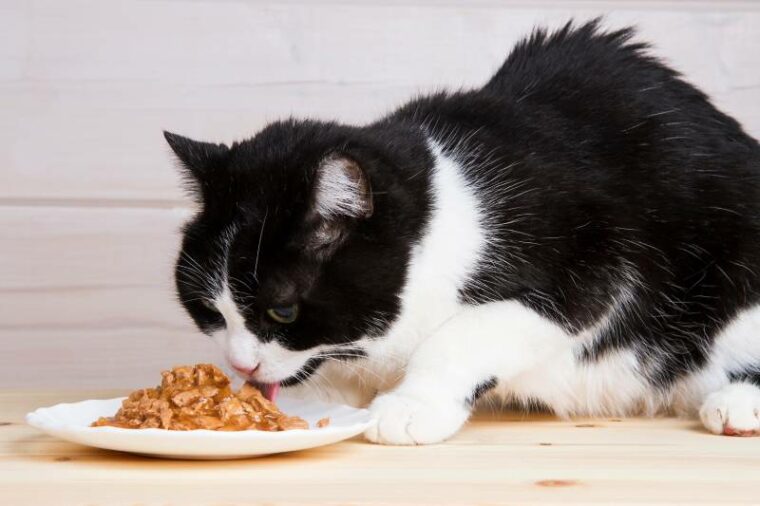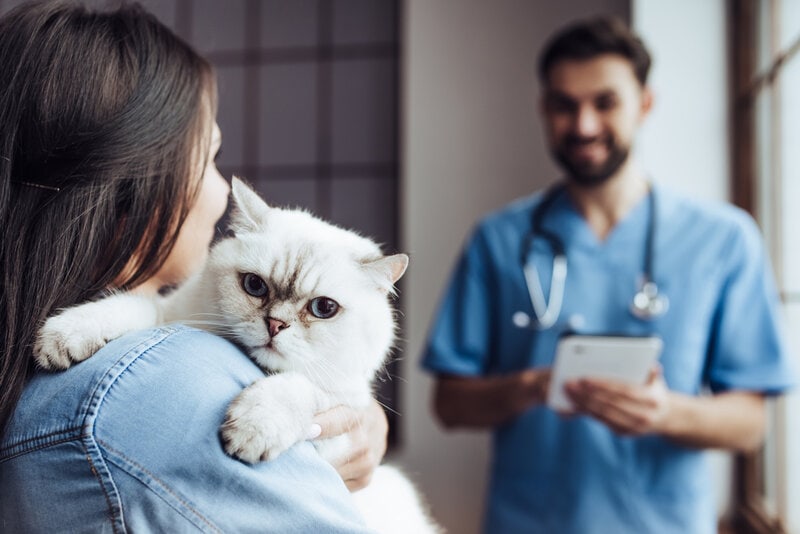
Kidney disease is a chronic disease that can be difficult to manage, especially in the later stages. It’s not uncommon for cats with kidney disease to lose muscle mass and body weight, and it can be difficult to support weight gain in these cats.
Chronic kidney disease (CKD) often causes nausea, a loss of appetite, and an overall feeling of illness that may cause cats to eat less. It’s important to help your cat with kidney disease maintain their body weight, but this should always be done under the guidance of your veterinarian. Depending on your cat’s blood pressure and blood and urine results your vet will classify their kidney disease into 4 different stages. Depending on the stage your cat is, your vet will create a treatment plan for your cat. ¹
The 7 Tips on How to Help a Cat With Kidney Disease Gain Weight
1. Feed a Prescription Diet
When your cat is diagnosed with chronic kidney disease, your vet will likely recommend a prescription diet for cats with kidney disease. For cats with kidney disease, there are certain nutritional elements that are overlooked by regular cat foods, like the need for a low level of phosphorus.
Prescription diets that have been formulated for cats with kidney problems are formulated with the specific nutritional needs of cats with kidney disease in mind, including helping to maintain body mass.
The food should be high quality and formulated to support the needs of cats with kidney disease. Renal diets feature phosphorus restriction, moderate high-quality protein, moderate sodium, high amounts of B vitamins, and alkalinization (likely the only feline diets to do so). They may include higher potassium levels than other diets, and some of them include long-chain omega 3 fatty acids.

2. Enhance the Palatability of Foods
Let’s be honest, nobody wants to eat food that doesn’t taste or smell good. Maintaining a highly palatable diet is one of the easiest and best ways to keep your cat with kidney disease eating enough. This can be difficult when your cat’s diet is restricted to a prescription diet, though.
Talk to your vet about ways to enhance the palatability of your cat’s food. Oftentimes, prescription diets can be made more palatable by feeding the wet food version of them, warming the food, or mixing wet and dry foods together. There are also multiple prescription kidney diets on the market, so you may find that one particular food works best for your cat.
3. Control Nausea
When you’re nauseated, you probably don’t feel like even trying to eat, right? The same is true for your cat. Kidney disease can result in underlying nausea, sometimes even constant nausea.
Nausea actively discourages your cat from eating, and it may cause vomiting when they finally do attempt to eat. It’s essential for all cats to eat, obviously, but cats can rapidly develop serious acute medical problems if they go even a couple of days without eating.
Your vet will be able to help you find the best ways to control your cat’s nausea. This will likely require you to give your cat a prescription anti-nausea medication, but there are multiple forms of these medications, so if you have difficulty giving pills, for example, you’ll have the option of liquid medications or compounded medications.
Nausea can also be improved with the management of kidney disease. Unfortunately, kidney disease becomes progressively more difficult to manage as time passes.
4. Give Appetite Stimulants
Appetite stimulants are a great way to encourage your cat to eat if they are nauseated or overall not feeling well. These medications are typically available only by prescription, but they can be a real lifesaver for cats with kidney disease. Supporting your cat’s appetite will not only support their body weight, but it can also help your cat gain back lost body weight.
A medication called mirtazapine is usually the first choice for supporting the appetite of cats. It’s available in multiple forms, and compounding pharmacies will compound mirtazapine into a highly palatable medication to make it easier to administer. If your cat is receiving an appetite stimulant that isn’t working for them, then you can talk to your vet about trying something different.

5. Support Hydration
Maintaining adequate hydration is of paramount importance for cats with kidney disease. They need to compensate for their fluid loss through urine with extra water intake. Hydration is extremely important for flushing toxins from the body that the kidneys are not adequately eliminating.
You can support hydration for your cat by feeding wet food or adding broth or water to their food. Your vet can teach you how to supplementally give your cat subcutaneous fluids or fluids below the skin. This fluid is absorbed by the body, and while this is less effective than intravenous (IV) fluids, it is very well accepted by cats at home. In the very late stages of the disease, your cat may also need IV fluids on a routine basis, but your vet will be able to guide you.
6. Talk to Your Vet
Your vet will be your best resource and cheerleader when it comes to managing your cat’s kidney disease. They are a wealth of knowledge and are the professionals who can retrieve all the medical information and create a treatment plan tailored for your cat.
Another thing that your vet may be a great resource on is adding high-calorie additives to your cat’s food. There are a variety of these on the market, but not all of them are safe for cats with kidney disease. Your vet will be able to help you better understand your cat’s needs and why a certain product is or isn’t appropriate for them.
7. Provide Supplemental Feeding
Supplemental feeding is usually a last-ditch effort to support cats with kidney disease who simply aren’t eating enough any other way. Supplemental feeding can be as simple as syringe feeding your cat watery food, or it may be as complex as having a permanent feeding tube placed and giving them feedings through the tube. This is only needed in certain situations.
You should never attempt to do any kind of forced supplemental feeding without consulting with your vet first. Aspiration and choking are real risks with force-feeding, and it’s important that you understand how to properly do it. If your cat is at the point that force-feeding them is the only way they are staying alive, though, then you need to have a frank conversation with your vet about your cat’s quality of life.

What to Consider With Home-Prepared Diets
If your cat is diagnosed with a serious disease like kidney disease, then you will obviously want to do everything in your power to keep your cat as healthy as possible for as long as possible.
For many people, they feel that preparing home-cooked or raw diets for their cats is the best way to support their health. In most situations, this isn’t the case for multiple reasons.
It’s exceptionally difficult to properly balance homemade cat food, and it’s even more difficult when your cat has a serious medical condition with specific nutrition needs. If you are set on preparing a homemade diet for your cat, then you need to have a consultation with a board-certified veterinary nutritionist or through a veterinarian-recommended website like BalanceIt.
You may also find that you’re happy with minimally processed foods that still meet the nutritional requirements for your cat with kidney disease, but make sure to discuss any dietary changes with your vet before switching the food.
When it comes to raw diets, they offer a far higher risk of food-borne illnesses than a cooked diet. Your cat’s immune system will be challenged already due to dealing with a serious illness, so avoiding risks like raw foods is often considered to be the best option. If you are interested in a raw diet, though, then you should discuss it with your vet.
Conclusion
Kidney disease is a difficult disease, but you do have options to help make things a little easier on your cat by supporting their appetite and body weight. It’s important for your cat to maintain their body weight so they have something to fall back on if they become more ill, but this will likely take extra work on your part to help your cat achieve.
Whenever you’re unsure of how to proceed, you should always check with your vet.
Featured Image Credit: Elizabett, Shutterstock







